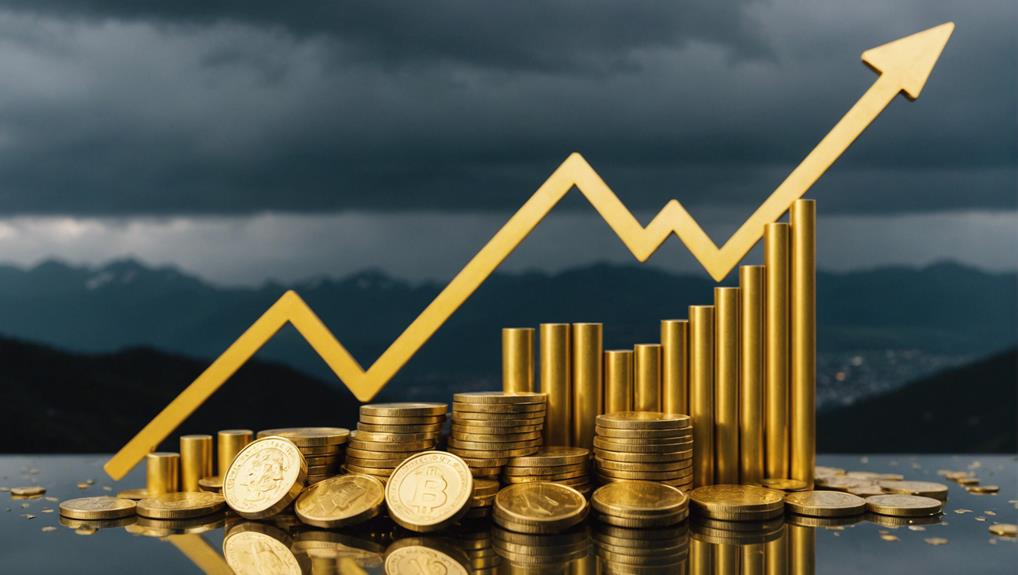When considering investing in gold, several risks could impact your returns. Price volatility is a primary concern, as market fluctuations due to various factors can lead to unpredictable outcomes.
Storing and securing gold can be costly and complicated, adding another layer of risk. Additionally, gold does not generate income and may present liquidity issues, making it harder to convert to cash swiftly.
Premium costs, market speculation, and other factors also warrant thorough investigation to better inform your investment strategy.
My Quick Highlights
- Gold prices are highly volatile due to economic conditions, geopolitical events, and investor sentiment.
- Physical gold requires secure storage and insurance, which adds to investment costs and complexity.
- Unlike stocks or bonds, gold does not generate income through dividends or interest, relying solely on price appreciation for profit.
- Selling physical gold can face liquidity issues because of authentication requirements and prevailing market conditions.
- Investing in gold may involve opportunity costs, as alternative assets could potentially offer higher returns.
Price Volatility

Gold prices are highly volatile, influenced by economic conditions, geopolitical events, and investor sentiment. Significant fluctuations in the daily spot price of gold, measured in US dollars per Troy ounce, are common. Understanding the factors driving these changes is crucial for investors as gold price volatility can significantly impact investment value.
Gold market liquidity, or the ease of buying and selling gold, also affects investment decisions. Utilizing various risks of investing in gold mutual funds platforms can offer more flexibility and access to real-time data.
To mitigate risks, consider strategies like diversification and risk management. These strategies help balance your portfolio and protect it from drastic price swings, ensuring a more stable investment.
Storage and Security
When investing in gold, you need to consider how you’ll store it safely. Safe deposit boxes at banks offer secure storage but can incur ongoing fees.
Alternatively, home security measures might provide convenience, though they may pose higher risks of theft or loss.
Safe Deposit Boxes
Utilizing a safe deposit box at a bank significantly enhances the security of your physical gold investments. Safe deposit boxes offer a secure storage solution, reducing the risks of theft or loss that come with keeping gold at home. Many banks also provide insurance coverage for items stored in these boxes, adding an extra layer of protection for your assets.
Rental fees for safe deposit boxes vary based on the size of the box and the bank’s location, which impacts the overall cost of storage. Accessibility can be a concern, as access to your gold may be limited during bank holidays or emergencies.
| Aspect | Advantage | Consideration |
|---|---|---|
| Security | Reduced theft risk | Limited access during bank holidays |
| Insurance | Additional coverage | Potentially higher rental fees |
| Cost | Variable rental fees | Costs depend on size and location |
Home Security Measures
To protect your physical gold assets at home, invest in a high-quality safe and robust security measures. Secure storage is crucial to guard against theft, damage, or loss. A home safe is a good start, but implementing additional security systems will further safeguard your investment.
- Alarm systems: These deter potential intruders and alert you to any unauthorized access.
- Surveillance cameras: Monitoring your property can provide evidence in the event of a break-in.
- Regular assessments: Update your home security regularly to address any vulnerabilities.
- Insurance coverage: Ensure your gold is insured to cover potential losses.
- Proper documentation: Maintain detailed records to assist in tracking and recovery if theft occurs.
Lack of Income Generation

Gold doesn’t generate income through dividends or interest payments like stocks and bonds do. When you invest in gold bullion, coins, bars, or ETFs (exchange-traded funds), your profit depends solely on price appreciation.
This lack of ongoing cash flow can be a disadvantage, especially if your investment strategy is focused on income generation. Gold’s value is mainly driven by supply and demand dynamics and serves as a risks of investing in gold IRAs during economic uncertainty.
While this can provide stability during market turmoil, your returns will rely entirely on market conditions. This can affect your overall portfolio returns, particularly if regular income is a priority in your strategy.
Liquidity Issues
Selling physical gold can be challenging due to additional steps and potential delays. Unlike other assets, physical gold, such as coins and bars, often requires authentication before resale, which can slow down transactions. Market downturns can further complicate this process as the demand for physical gold surges, causing additional delays.
Understanding liquidity issues is crucial for those needing quick access to funds.
Important considerations include:
- Authentication requirements for gold coins and bars
- Potential delays during high-demand periods
- Additional costs associated with selling physical gold
- Faster liquidity with gold ETFs compared to physical gold
- Market conditions impacting the ease of selling
Awareness of these factors helps in making informed investment decisions.
Premium and Tax Costs

When investing in gold, you need to consider both premium and tax costs that can significantly impact your returns. Physical gold often carries a premium of 5% to 10% above the spot price, and gains from selling it are taxed at a higher rate of 28%.
Moreover, storage and insurance fees can add up, further affecting your overall profitability.
Storage and Insurance Fees
Storing and insuring physical gold can significantly impact your investment returns, with annual fees and premiums accumulating quickly. These expenses can diminish the benefits of rising gold demand and spot prices.
Here’s a breakdown of potential costs:
- Storage fees: 0.5% to 1% of your gold’s value annually.
- Insurance costs: An additional 1% to 2% each year.
- Purchase premiums: Physical gold often sells at 5% to 10% above the spot price.
- Secured storage: Higher security typically incurs higher fees.
- Additional costs: Miscellaneous fees like transportation should also be considered.
Balancing these expenses is crucial for maximizing your overall returns.
Capital Gains Tax
Understanding capital gains tax is crucial for effectively managing the financial implications of your gold investments. When you sell gold, the profit you make may be subject to capital gains tax, which varies based on the holding period of the asset.
Selling gold within a year incurs short-term capital gains tax, typically at a higher rate. In contrast, holding gold for more than a year qualifies you for lower long-term capital gains tax rates, offering risks to consider before investing in gold ETFs.
Considering these tax implications when buying and selling gold investments is essential. Proper planning can help you maximize returns and minimize tax burdens, making your investment decisions more informed and strategic.
Market Speculation
Speculative trading significantly influences gold prices, leading to short-term fluctuations that investors need to monitor closely. Speculators engaged in gold futures amplify market volatility, often causing prices to deviate from their fundamental values. This creates an unpredictable market environment.
Key considerations include:
- Gold futures: Contracts to buy or sell gold at a future date, commonly utilized by speculators.
- Market volatility: Rapid and unpredictable price changes.
- Price fluctuations: Frequent and sharp changes in gold prices.
- Speculative trading: Transactions based on market trends rather than fundamental values.
- Impact on investments: Speculation can lead to temporary mispricing, influencing investment decisions.
Understanding these factors is crucial for managing gold investments wisely.
Geopolitical Risks

Investing in gold necessitates managing geopolitical risks, as events like wars, elections, and policy changes can notably impact prices. These risks often drive up the demand for gold as a safe haven, with investors seeking stability during uncertain times.
For example, geopolitical tensions frequently lead to increased gold prices because gold is perceived as a secure investment. Legislation changes or shifts in government policies can also influence gold prices and overall risks of investing in gold stocks.
This geopolitical uncertainty can cause fluctuations in gold’s value, making it crucial for investors to stay informed. By considering these factors, you can make more informed decisions and better prepare for potential market shifts.
Fraud and Scams
Geopolitical risks can influence gold prices, but it’s equally crucial to be aware of fraud and scams in the gold investment market. Scammers often exploit market volatility and economic uncertainties, targeting unsuspecting investors with fraudulent schemes.
Vigilance against gold market frauds and deceptive investment offers that promise unrealistic returns is essential. Phony brokers mightn’t have your best interests at heart. To protect yourself:
- Verify the legitimacy of brokers and investment firms.
- Be cautious of offers that sound too good to be true.
- Avoid investments not backed by tangible assets.
- Research historical instances of gold market frauds.
- Consult with trusted financial advisors.
Staying informed and cautious helps you avoid falling victim to these scams.
Opportunity Cost

When investing in gold, you must consider the opportunity cost of potentially higher returns from alternative assets like stocks or bonds. Opportunity cost refers to the potential gains you forgo by choosing one investment over another.
3 drawbacks to consider before investing in gold’s price movements can be unpredictable, and market volatility mightn’t always align with other investment opportunities. This can significantly affect your opportunity cost. For instance, gold ETFs track the gold price index but may still underperform compared to a bullish stock market.
Understanding and calculating the opportunity cost will help you make more informed decisions about allocating your funds. Weigh the potential returns from gold against those from other investments to ensure your portfolio is well-balanced and optimized.
Conclusion
In conclusion, investing in gold requires navigating several risks. Be aware of price volatility, storage and security needs, and the lack of income generation.
Liquidity issues, premium and tax costs, and market speculation also play significant roles. Consider geopolitical risks, potential fraud, and the opportunity cost of gold stock investments.
Understanding these factors helps in making more informed decisions and better managing your gold investment.
The Gold Information Network
11900 Biscayne Blvd, Ste 127B, Miami, FL 33181
(305) 449-9094
https://goldinfo.net







